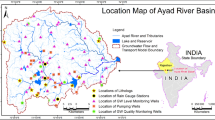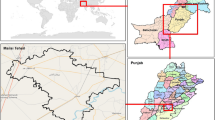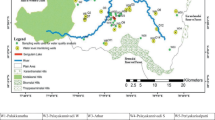Abstract
Hydrogeochemical characteristics of 24 groundwater samples are investigated in the BKB landfill, Khon Kaen Province, Thailand. The Phong River bounds this region's dividing edge between highlands and lowlands and local streams called the SS sub-basin. The groundwater's major ions and heavy metals are compared in both wet and dry seasons. Water types of groundwater based on total dissolved solids between 100 and 900 mg L−1 are mainly the Na-Ca-(or Ca-Na)-Cl-HCO3 in the wet season, while the Na-Ca-Cl-HCO3 and Na-Cl in the dry season. These water types mostly reveal groundwater mixing, except the Na-Cl one. Heavy metals of Fe, Mn, Cd, Pb, and Cr are examined with results in the average of 0.73, 0.64, 4.32, 0.146, and 0.145 mg L−1, respectively. Their distributions are associated with the groundwater flow direction in a radius of approximately 500–1000 m from the center of this landfill, affected by topography. The west area shows the dispersion of heavy metals affected the North and East streams. Leaking is down to the sandstone aquifer at a depth of about 50 m from the surface to the stream in the North area. These heavy metals are distributed West and the East of the SS sub-basin. Therefore, mass distributions are associated with the groundwater flow direction. Hydrogeochemical characteristics of groundwater are useful to indicate the groundwater flow direction, which can be applied for groundwater modeling to enhance the understanding of heavy metals transport.
Access provided by Autonomous University of Puebla. Download conference paper PDF
Similar content being viewed by others
Keywords
- Hydrogeochemical groundwater
- Groundwater modeling
- Landfill
- Hydrogeochemical characteristics
- Waste disposal site
1 Introduction
The waste disposal site, BKB landfill, in Mueang Khon Kaen District, Khon Kaen Province, produces around 720 kt of solid waste per year (Pollution Control Department [PCD], 2016). The daily amount of rubbish dumped (without waste separation) produced by Khon Kaen city is approximately 1300 t of new garbage, including 300 kg of toxic wastes (Nathanri, 2021), with an increasing annual rate of around 10%. The study area for hydrogeochemical groundwater modeling is located in the BKB landfill, covering an area of approximately 53 km2. Contaminant distribution by source from this landfill is underlined by an unconfined aquifer and layer of rocks, which consist of lateritic sand and gravel locally flowing from the North-West to the South-East (Boonsener et al., 1994).
Groundwater is the main living factor in this region, especially in drought areas. The community in the surrounding area of this landfill relies on the groundwater of both shallow wells of the unconfined aquifer (< 10 m of water depth) and deep wells of the confined aquifer (~ 30 m depth), which is supported by a semi-green sandstone layer (Srisuk, 1994). Groundwater flows in consolidated rocks along fractures rocks of shale, sandstone, and siltstone in the Khorat Group (Khok Kruat, Phu Phan, and Sao Khua Formations) beneath an evaporite layer is very distinctive around 27–1000 m3 per day (Srisuk & Lertsirivorakul, 1984). Contaminants affected by this landfill could disperse, covering the surface soil or infill to the groundwater resulting in water quality. The water quality of the groundwater model can reveal plumes of contaminants along with the flow direction of groundwater. Thus, this research aims to evaluate the hydrogeochemical characteristics of groundwater related to the groundwater model in the BKB landfill in Khon Kaen Province, Thailand.
2 Materials and Methods
The study area of the BKB landfill covers an area of 53 km2 in Mueang District, the northern part of Khon Kaen city, based on the UTM Grid Reference System in 48Q 0262000E-0272500E and 1833500N to 1838500N, as the SS sub-basin. Groundwater samples are collected from 24 stations nearby the landfill in the dry season (December 2019) and in the wet season (July–August 2020). Physico-chemical parameters of groundwater are determined in the field, such as pH, temperature (T), electrical conductivity (EC), dissolved oxygen (DO), and oxidation–reduction potential (ORP). The total dissolved solids (TDS) value is obtained by evaporation at 105 °C in the oven, whereas major ions and some heavy metals (Fe, Mn, Cd, Pb, and Cr) are examined using spectroscopy techniques. The controlling process of groundwater then verifies the hydrogeochemical speciation. In contrast, the surfer program traces the flow direction based on the hydraulic head and the elevation. Heavy metals transport profiles and hydrogeochemical characteristics of groundwater are mathematically evaluated (simulating) groundwater flow through aquifers at the steady-state condition using the US Geological Survey Modular Finite-difference Flow Model (MODFLOW) software.
3 Results and Discussion
3.1 Physico-chemical Analysis
The pH, T, EC, DO, and ORP are measured in the field and presented in the physicochemical plot (Fig. 1). These parameters are essential to evaluate the hydrogeochemical characteristics of groundwater. Water types of groundwater based on TDS between 100 and 900 mg L−1 are determined as mainly the Na-Ca-(or Ca-Na)-Cl-HCO3 in the wet season and the Na-Ca-Cl-HCO3 and Na-Cl in the dry season. Heavy metals of Fe, Mn, Cd, Pb, and Cr are in the average of 0.73, 0.64, 4.32, 0.146, and 0.145 mg L−1, respectively. Astonishingly, heavy metals are found nearby the BKB landfill. Moreover, distributions of heavy metals are correlated to the groundwater flow direction, e.g., as illustrated in Fig. 2 for Pb.
3.2 Mass Transport Modeling
Spatial distributions of heavy metals in the landfill leachate show the downflow with a steep gradient along the stream from the north and south to the East. Pb contaminant is chosen for groundwater modeling due to its toxicity and harmful to human health. It releases at the north side and flows down from the surface to unconsolidated sandstone (KK) at ~ 50 m in depth (Fig. 3), which correlates to the groundwater flow direction.
4 Conclusion
Groundwater modeling of heavy metals transport in waste disposal site, BKB landfill is correlated with groundwater’s hydrogeochemical characteristics and flow direction. This approach enhances our understanding of heavy metal migration, providing valuable insights for effective remediation strategies and environmental conservation efforts of groundwater preservation.
References
Boonsener, M., Buaphan, C., Kothaphan, J., & Suksomrot, S. (1994). The contamination of shallow aquifer from landfill leachate case study: Khon Kaen town. In Technology and Northeast Development Conference (pp. 334–362). Department of Geotechnology, Faculty of Technology, Khon Kaen University.
Nathanri, J. Khon Kaen biggest rubbish dump in NE. Bangkok Post. http://www.bangkokpost.com/Thailand/general/khon-kaen. Accessed May 1, 2021.
Pollution Control Department (PCD). (2016). Thailand State of Pollution Report 2016. Pollution Control Department, Ministry of Natural Resources, Bangkok, Thailand.
Srisuk, K. (1994). Genetic characteristic of the groundwater regime in Khon Kaen Drainage Basin, Northeast Thailand (Ph.D. Thesis). University of Alberta, Canada.
Srisuk, K., & Lertsirivorakul, R. (1984). Hydrogeology of Amphoe Muang Changwat Khon Kaen. Department of Geotechnology, Faculty of Technology, Khon Kaen University.
Author information
Authors and Affiliations
Corresponding author
Editor information
Editors and Affiliations
Rights and permissions
Copyright information
© 2023 The Author(s), under exclusive license to Springer Nature Switzerland AG
About this paper
Cite this paper
Saengsri, S., Promkotra, S., Cotanont, T., Kangsadan, T. (2023). Hydrogeochemical Groundwater Modeling in Waste Disposal Site, BKB Landfill, Thailand. In: Chenchouni, H., et al. Recent Research on Hydrogeology, Geoecology and Atmospheric Sciences . MedGU 2021. Advances in Science, Technology & Innovation. Springer, Cham. https://doi.org/10.1007/978-3-031-43169-2_20
Download citation
DOI: https://doi.org/10.1007/978-3-031-43169-2_20
Published:
Publisher Name: Springer, Cham
Print ISBN: 978-3-031-43168-5
Online ISBN: 978-3-031-43169-2
eBook Packages: Earth and Environmental ScienceEarth and Environmental Science (R0)







